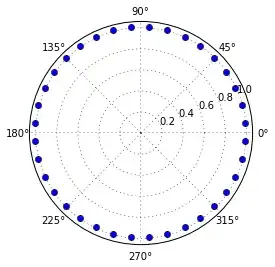I suggest you to take a look at the book "Topics in circular statistics" of Jammalamadaka if you are interested in circular variable.
Suppose that your data come from a circular distribution $F()$, and you want to model the (circular) mean of the circular variable:
what is generally used is:
$$
E(\theta) = 2\arctan(\boldsymbol{\beta}\mathbf{z}_i)
$$
$\theta$ is the circular variable, $\boldsymbol{\beta}$ is the vector of regression coefficients and $\mathbf{z}_i$ are the linear covariates.
If you want a parallelism with the usual linear regression you can assume that $\theta_i \sim WN(\mu_i,\sigma^2)$, where $WN()$ indicates the wrapped normal distribution that is in some sense the Normal distribution on a circle. Then
$$
\mu_i = 2\arctan(\boldsymbol{\beta}\mathbf{z}_i)
$$
or equivalently
$$
\theta_i = 2\arctan(\boldsymbol{\beta}\mathbf{z}_i) + \epsilon_i
$$
where $\epsilon_i \sim WN(0, \sigma^2)$
This type of regression is implemented in the package $circular$ that the user Scortchi suggests
